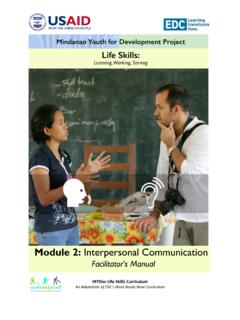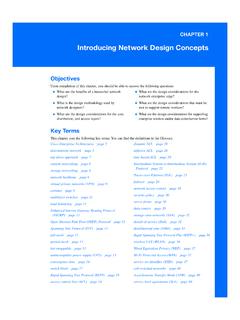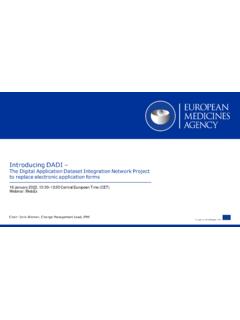Transcription of Cultural diversity and information and communication ...
1 International Education Studies Vol. 4, No. 2; May 2011 Published by Canadian Center of Science and Education 111 Cultural diversity and information and communication impacts on Language Learning Wang Wen-Cheng Department of Business Management, Hwa Hsia Institute of Technology, Taiwan 111 Gong Jhuan Rd., Chung Ho, Taipei, Taiwan, Tel: 886-289-415-156 E-mail: Lin Chien-Hung Department of Business Management, Hwa Hsia Institute of Technology, Taiwan 111 Gong Jhuan Rd.
2 , Chung Ho, Taipei, Taiwan, Tel: 886-289-415-022 E-mail: Chu Ying-Chien Department of Tourism and Leisure National Penghu University, Taiwan 300 Liu-Ho Rd., Makung city, Penghu, Taiwan, Tel: 886-926-4115 E-mail: Received: September 10, 2010 Accepted: September 28, 2010 Abstract Cultural diversity doesn t just entail differences in dress and language. It also encompasses different ways of thinking, managing, and communicating. The relationship between communication and culture is a very complex and intimate one.
3 Cultures are created through communication ; that is, communication is the means of human interaction through which Cultural characteristics are created and shared. People use language for purposeful communication and learning a new language involves learning how to use words, rules and knowledge about language and its use in order to communicate with speakers of the language. In this paper, the first section attempts to illustrate communications and culture transformation; the second section focuses on the ways in which people s world-views affect languages learning, understanding, and interaction; the third section discusses the diverse Cultural stratifications between eastern and western cultures values.
4 Keywords: Cultural diversity , communication , Learning, Cultural stratifications 1. Introduction Culture is a word with many shades of meaning. It is defined in Longman Dictionary of Language Teaching & Applied Linguistics as the total set of beliefs, attitudes, customs, behavior, social habits, etc. of the members of a particular society. Indeed, the origin of language, understood as the human capacity of complex symbolic communication , and the origin of complex culture is often thought to stem from the same evolutionary process in early man.
5 Culture is a word with many shades of meaning. It is defined in Longman Dictionary of Language Teaching & Applied Linguistics as the total set of beliefs, attitudes, customs, behavior, social habits, etc. of the members of a particular society. The specifics of the relationship between language change and Cultural change are mediated by an intricate array of factors, including local Cultural resources, rights, and persons and the ways that local details of drift in language change are linked to these by language ideologies.
6 Language and culture then both emerged as a means of using symbols to construct social identity and maintain coherence within a social group too large to rely exclusively on pre-human ways of building community such as for example grooming. Since language and culture are both in essence symbolic systems, twentieth century Cultural theorists have applied the methods of International Education Studies Vol. 4, No. 2; May 2011 ISSN 1913-9020 E-ISSN 1913-9039 112 analyzing language developed in the science of linguistics to also analyze culture.
7 Hence, culture is more than a collection of disconnected acts and beliefs; rather, it should be seen as an integrated set of norms or standards by which human behaviors, beliefs, and thinking are organized. In general terms, culture is most commonly viewed as that pattern of knowledge, skills, behaviors, attitudes and beliefs, as well as material artifacts, produced by a human society and transmitted from one generation to another. Cultural pluralism is referred to as an idea that seeks to encourage Cultural diversity and establishes a basis of unity so that America can become a cohesive society whose culture is enriched by sharing widely divergent ethnic experiences (Pai, 1990).
8 Foley (1997) culture itself as well as the study of culture would have to undergo certain changes or face becoming obsolete. Symbolic anthropology is considered to be one of such transformations regarding the theoretical interpretation Cultural anthropologists are concerned with. This would suggest that culture and language are inseparable by nature if one were to take into account the notion that the meanings of a word are structured around Cultural practice and are therefore constrained to that culture.
9 Cultural similarity in perception makes the sharing of meaning possible. There is probably no definitive answer explaining why a particular culture assigns certain meanings and worth to a given set of events, objects, or acts. It is essential to cultivate an attitude of respect for and appreciation of worth of Cultural diversity , to promote belief in worth of the individual, to develop competencies, and to facilitate educational equity (Pai, 1990). The difference between languages does not consist only in differences in pronunciation, vocabulary or grammar, but also in different cultures of speaking.
10 Other languages may use different forms of address when speaking to speakers of the opposite gender or in-law relatives and many languages have special ways of speaking to infants and children. Among other groups, the culture of speaking may entail not speaking to particular people. 2. communication and Cultural diversity Culture and communication , although two different concepts, are directly linked. communication the ability to share each other s ideas and feelings is the basis of all human contact, while culture is learned, acted out, transmitted, and preserved through communication .


















